Look, I get it. One day you entered your open kitchen, and you said to yourself; we have a wonderful space, but where is my kitchen and where is my living room? Believe me, you are not the only one in this fight. The open kitchens are great as a place of entertainment and extending your home but there are occasions whereby you would need a bit of definition without constituting the walls and destroying that beautiful flow.
I had the same dilemma and have attempted (and failed) using a number of strategies, and I have figured out how to split an open kitchen in a beautiful way and maintain all the magic of an open kitchen. Are you willing to change your space? We should discuss it as we were planning your dream-kitchen over the coffee.
Why Your Open Kitchen Needs Some Boundaries
That is the point of open kitchens they are amazing until they are not. Have you ever prepared a good smelling fish meal when people are reclining in your living room? Yeah, not ideal :/
Designing areas in your open kitchen helps it to retain the spaciousness and provide functionality. You retain the social element that has made open kitchens so popular, however, you also have separate spaces that can be used in different ways.
What is impressive is the fine separation methods which add to, but not interrupt, your space. Just imagine building rooms that have no walls – it cannot be done, and at the same time, it can be done in a completely realistic way, with the correct strategy.
Kitchen Islands: Your Best Friend for Beautiful Division
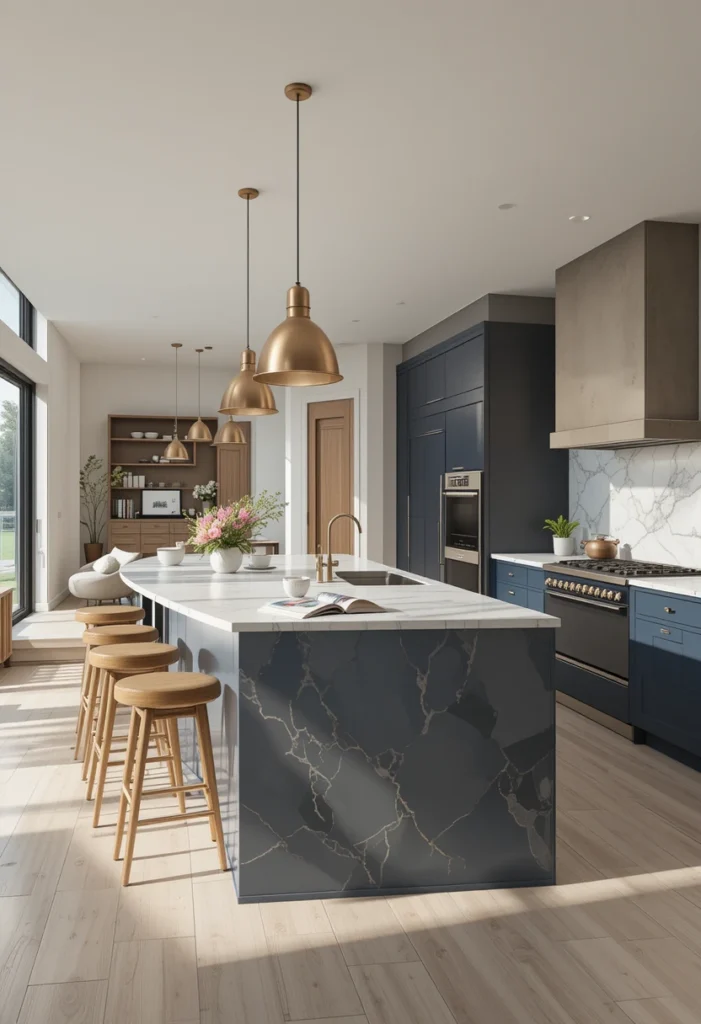
I will begin with my own favorite item which is kitchen islands. Three years ago, I purchased one to my open kitchen and, frankly speaking, everything has changed. Islands do not only offer additional counter space, but they are also natural room dividers that look intentional and beautiful.
Choosing the Right Island Size
Your island needs to fit your space perfectly. Here’s what works:
• Large kitchens: Go for islands that are 8-10 feet long • Medium spaces: 6-8 feet works beautifully
• Compact areas: Even a 4-foot island can create definition
The key? Ensure that there is a minimum of 36 inches of a walkway around your island. Do not take it from me, I found it difficult when I had people coming to my house and they kept bumping into my large island when I had a party.
Multi-Level Islands for Extra Definition

Want to get fancy? The islands are further aesthetically divided into multi-levels. I am referring to the height of your primary prep surface (standard height 36 inches or so) and then a higher setting of a bar zone at 42 inches. This provides you a definite eating area which is facing your living room with the untidy cooking stuff being concealed.
| Island Feature | Benefit |
|---|---|
| Standard Height (36″) | Perfect for food prep and cooking |
| Bar Height (42″) | Creates dining space and visual barrier |
Flooring Changes: Subtle Yet Effective Division
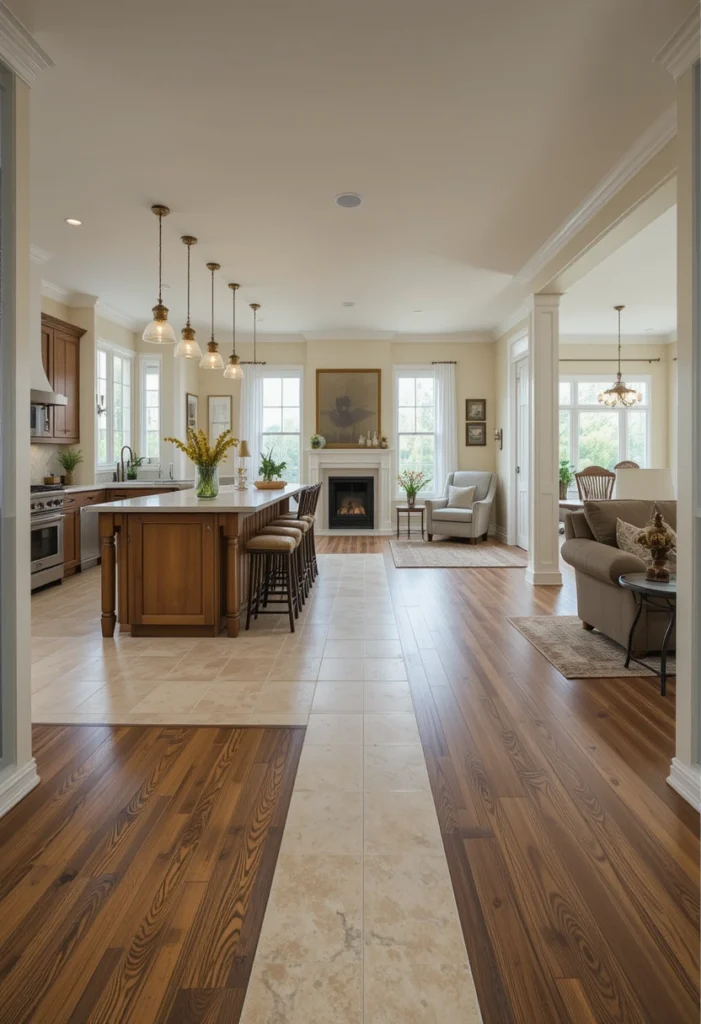
Have you ever noticed how flooring material will give you an immediate indication of a change in room? The strategic flooring transitions are like magic to separate open kitchens and no one can imagine how much difference this small change could have.
Material Combinations That Actually Work
I have visited too many houses with flooring changes that are not even thought about. This is what beautiful division really consists of:
Kitchen surface: Stick to the practical and use such materials as tile, luxury vinyl, or sealed concrete. they are sturdier than strong against spills and people walking over them.
Living side: Reverting to warmer surfaces such as hardwood, laminate or area rugs which encourage rest.
The change in these materials forms an organic line in the boundary, which is picked up as soon as the eye notices. Pro tip: Use transition strips which complement both materials as opposed to attempting to disguise the transition.
Creating Flow Despite the Division
The flooring division trick is in the selection of the materials that complement one another. You are not attempting to make jarring effects between the contrasts – you desire harmony between them. Imagine wood or cream-colored tile, or gray high-end vinyl or charcoal hardwood.
Lighting Design: The Unsung Hero of Kitchen Division
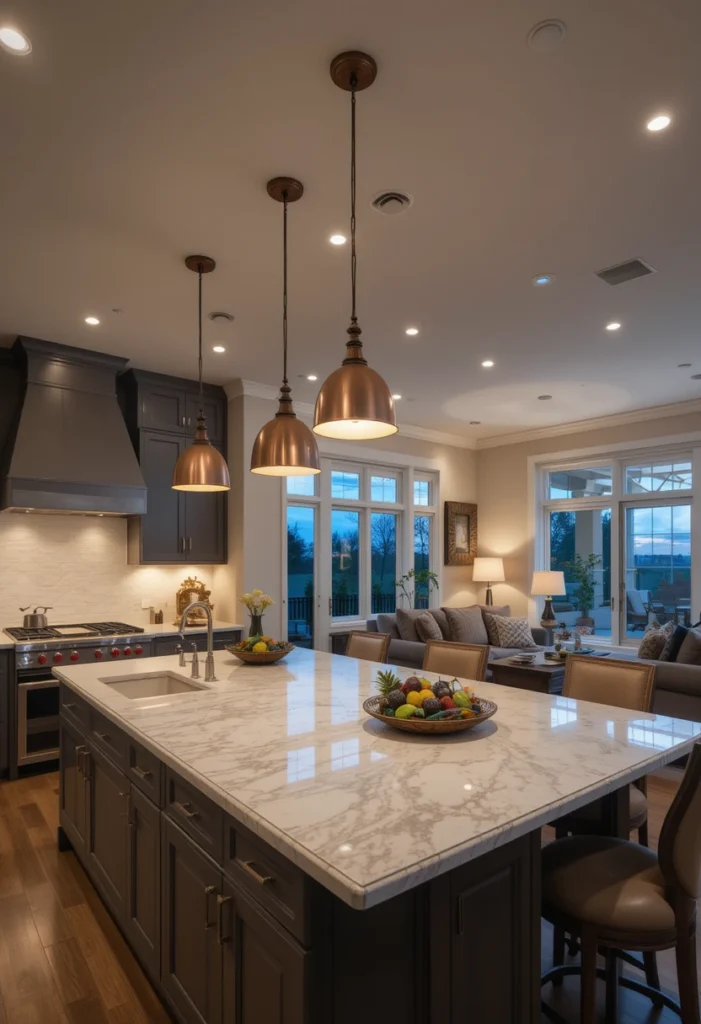
The underestimated technique of separation of open kitchens is lighting. Various lighting areas form different atmospheres and there are no physical barriers between them and the results can be simply breathtaking.
Task Lighting vs. Ambient Lighting Zones
Your kitchen area must have an efficient well-lit place to cook and prepare food. It is pendant lights across islands, LED strips within cabinets and under-cabinet and perhaps some recessed ceiling lights as well.
The living area desires less harsh and natural lighting that would welcome conversation and rest. Table-lamps, floor-lamps, and dimmable lamps are ideal in this place.
Such lighting difference automatically leads eyes of people and generates psychological boundaries. It is as though you have some unseen walls which make your place even more beautiful rather than making it shut.
Pendant Lights as Visual Dividers
Pendant lights work here well (pun intended). The visual ceiling that results when pendant lights are hung in your kitchen island will define your area of cooking. I picked three giant copper pendants to my kitchen and they have turned out to be a topic of discussion each and every time.
The trick is to select pendants that will match your general design but at the same time that are heavy enough to establish that aesthetic boundary. Minuscule, dinky pendants will not do the trick, fixtures with panache are required.
Furniture and Decor: The Flexible Approach
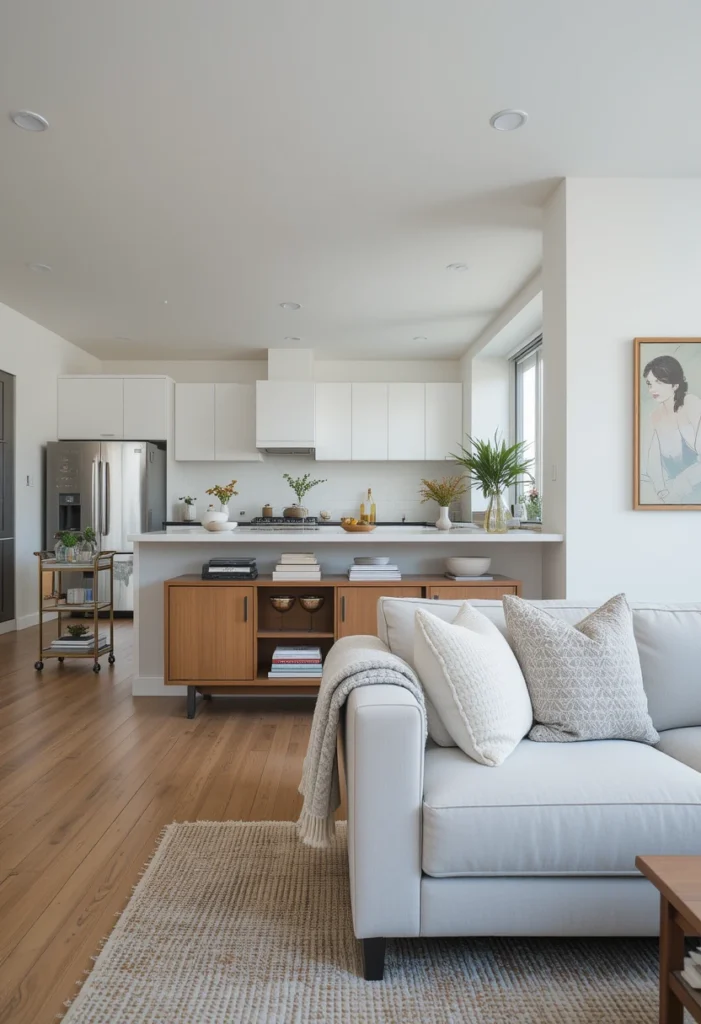
The most perfect split is sometimes made by the strategic furniture arrangement and decoration. This is an excellent idea when renting or not interested in making permanent changes.
Console Tables and Bar Carts
An apt console table that is placed behind your couch can form a natural division between your living and kitchen space. I have mine where I keep cook books and pretty bowls – it is useful and pretty.
Bar carts are like them but provide mobility. You can roll them wherever you want and they also have provisions of additional storage in case of entertainment. By the way, my one is changed at least twice a week according to what I cook!
Rugs as Room Definers
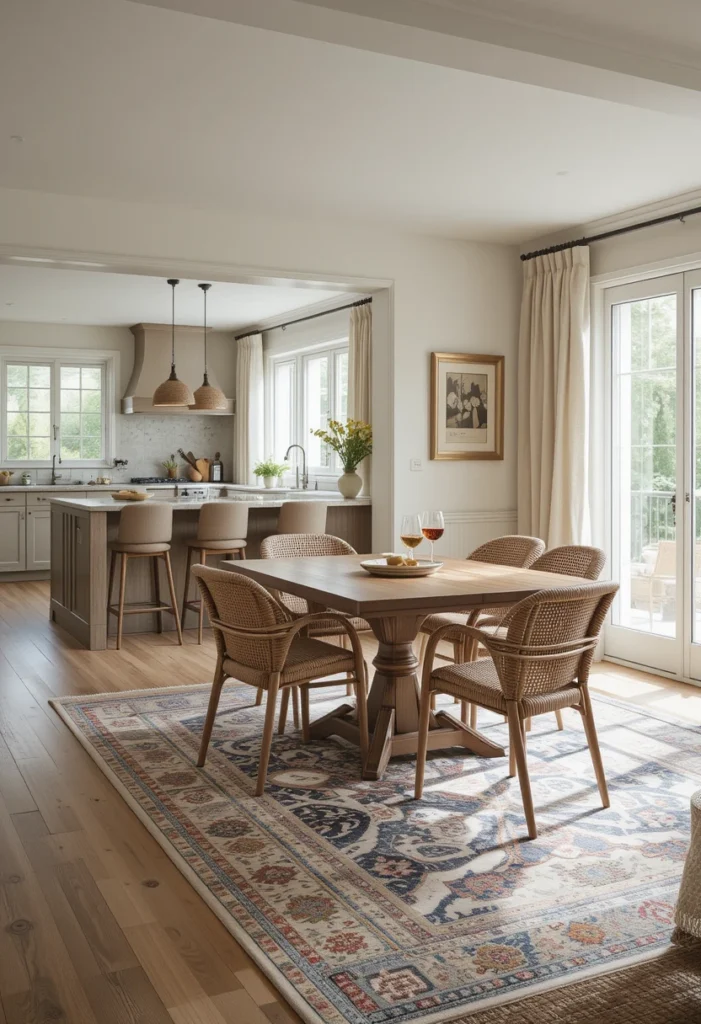
The influence of a good area rug should never be underestimated. Your kitchen area is instantly identified by a big rug on the floor under your dining table or under your living room.
Select rugs that are suitable to accommodate some of the kitchen spillage – no one would want to worry about every single spill on their new rugs of which it is beautiful:/
Color and Design Schemes: Cohesive Yet Distinct
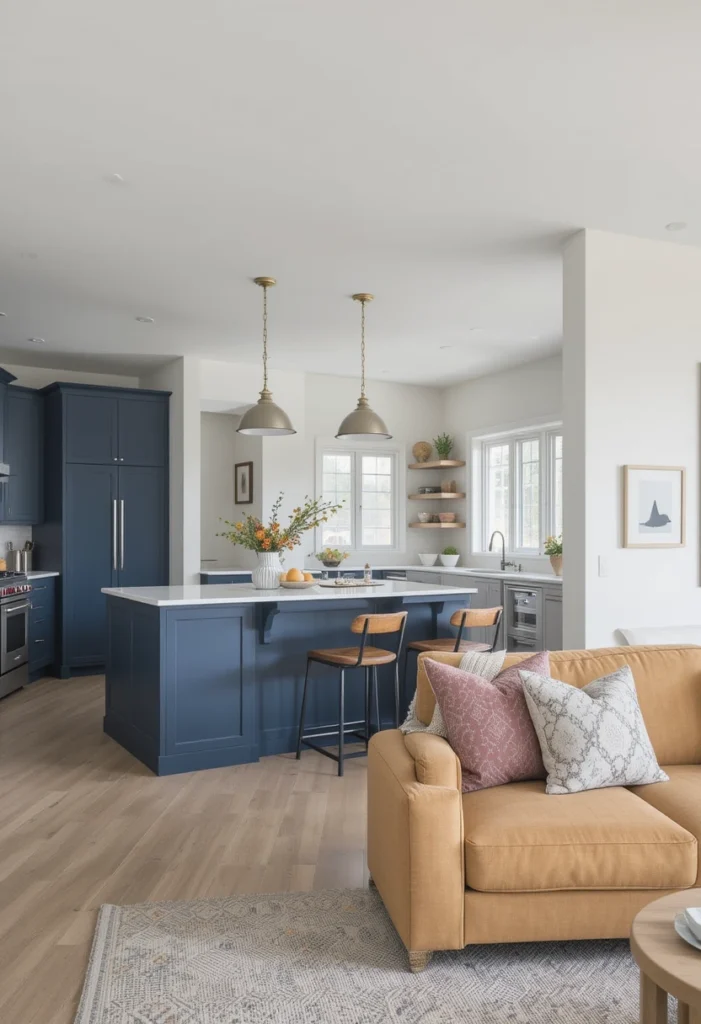
To form beautiful division does not mean that your spaces should have totally different color schemes. The magic of it is the like colors used with the varying intensities or the accent colors used to delineate particular areas.
The 60-30-10 Rule for Open Spaces
I swear by this design rule for open kitchens:
= 60 percent neutral: Have the same neutral colour on both spaces = 30 percent secondary colour: Select one colour on bigger objects such as cabinets or furniture.
Accent color- 10%: Keep color differences in each zone different.
Such a method maintains the unity but gives you the opportunity to make minor differences in your kitchen and living spaces.
Cabinet Colors That Create Definition
The cabinets in your kitchen are a massive potential to create visual difference. Although the walls in your living place may be light, the darker cabinets in the kitchen can create the cooking space beautifully.
I selected dark navy cabinets on white walls and the combination of the mismatch brings about a distinct kitchen area and yet also elegant instead of shocking.
Architectural Elements: When You Want Something Permanent
Are you willing to make some long term adjustments? These architectural details can be made beautiful division that is constructed in-place and purposeful.
Half Walls and Pony Walls
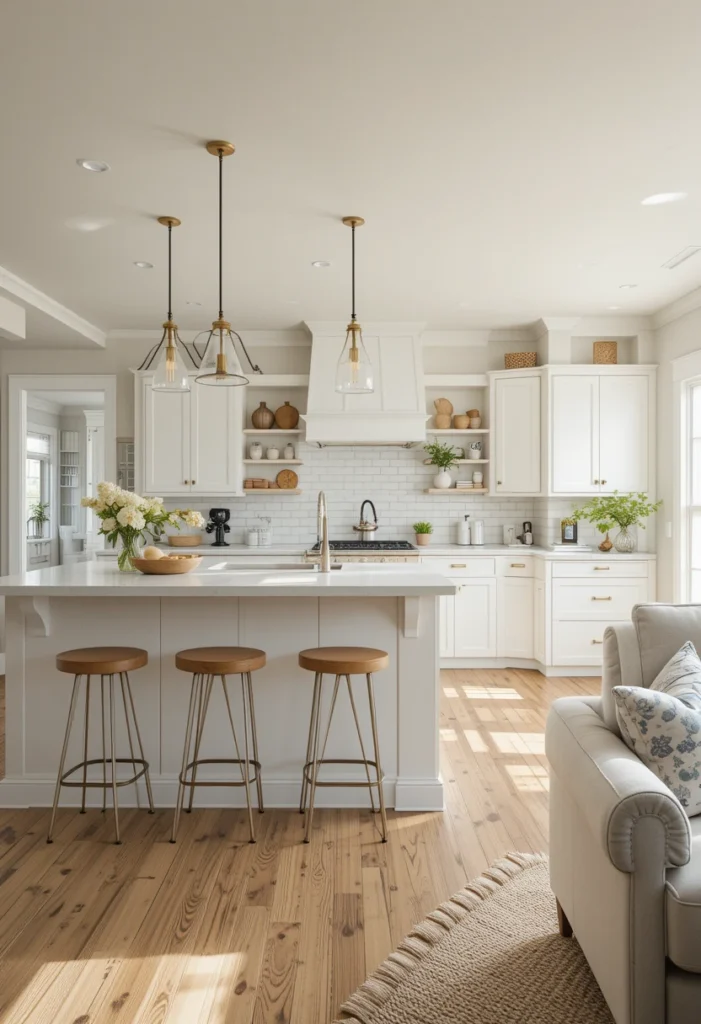
Pony walls (also known as half walls) provide privacy without obstructing views and natural light. Add a breakfast bar on top of them and now you have created functional division which in fact provides utility to your space.
The height sweet spot? Approximately 42-48 inches – high enough to conceal kitchen clutter, yet low enough to retain the openness.
Ceiling Details and Beams
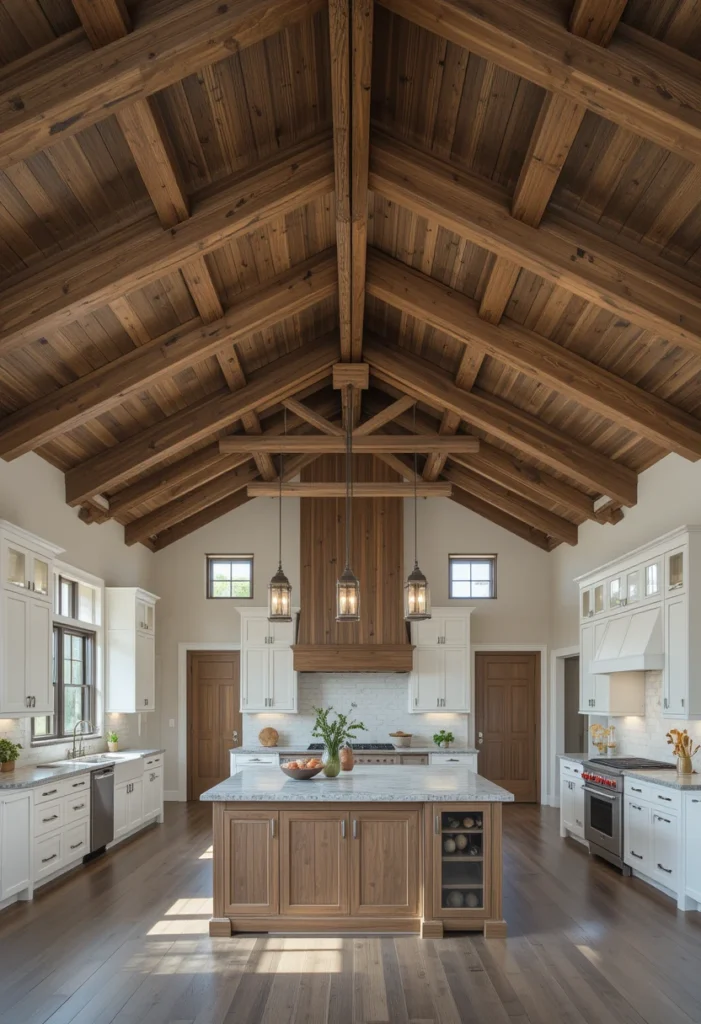
Your kitchen area may be characterized by exposed beams or coffered ceiling sections above your kitchen. This is best in the homes that have higher ceilings and you can afford to play around with overhead designs.
Minor definition of zones can occur even in paintededing areas in varying hues. Conceive a bit darker color in your kitchen which will match with the rest of your color scheme.
Storage Solutions That Double as Dividers
Why not have your division do a second shift? Boundaries can be achieved through strategic placement of storage as it solves your needs in the organization.
Open Shelving Systems
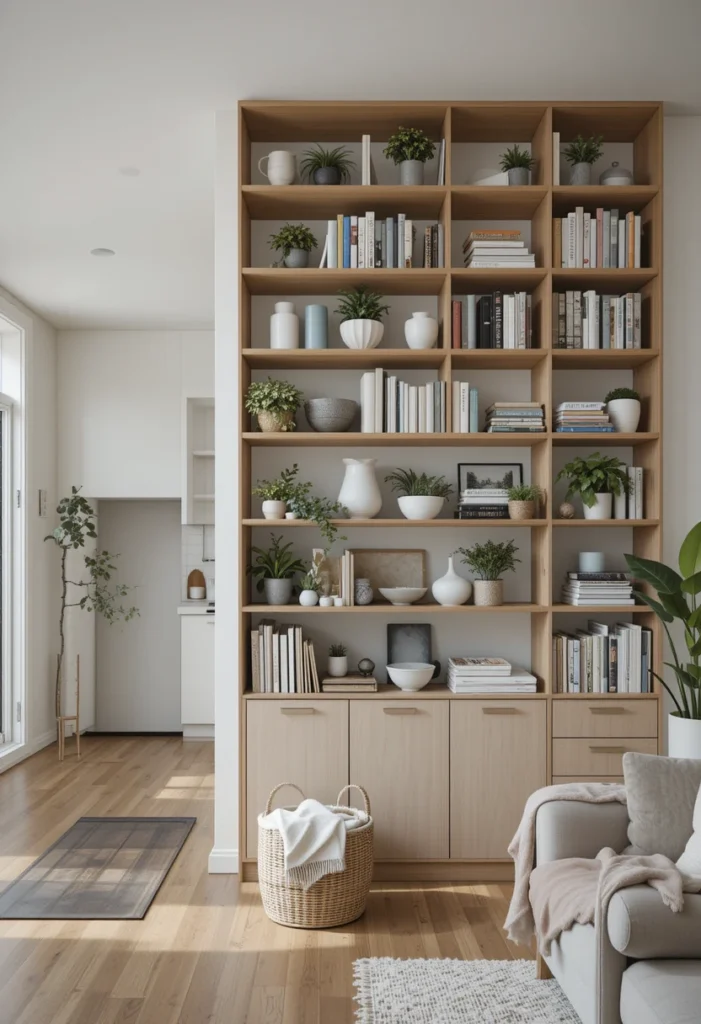
You can use tall, open shelving units that are positioned perpendicular to your kitchen to bring about division in your kitchen and still maintain that open look. Place them on to showcase gorgeous recipes, cookbooks, or anything that attracts a beautiful display that adds to your overall style.
It is all about maintaining these shelves in order and making them look nice, no more storage, they are now a part of your room.
Built-in Banquettes and Seating
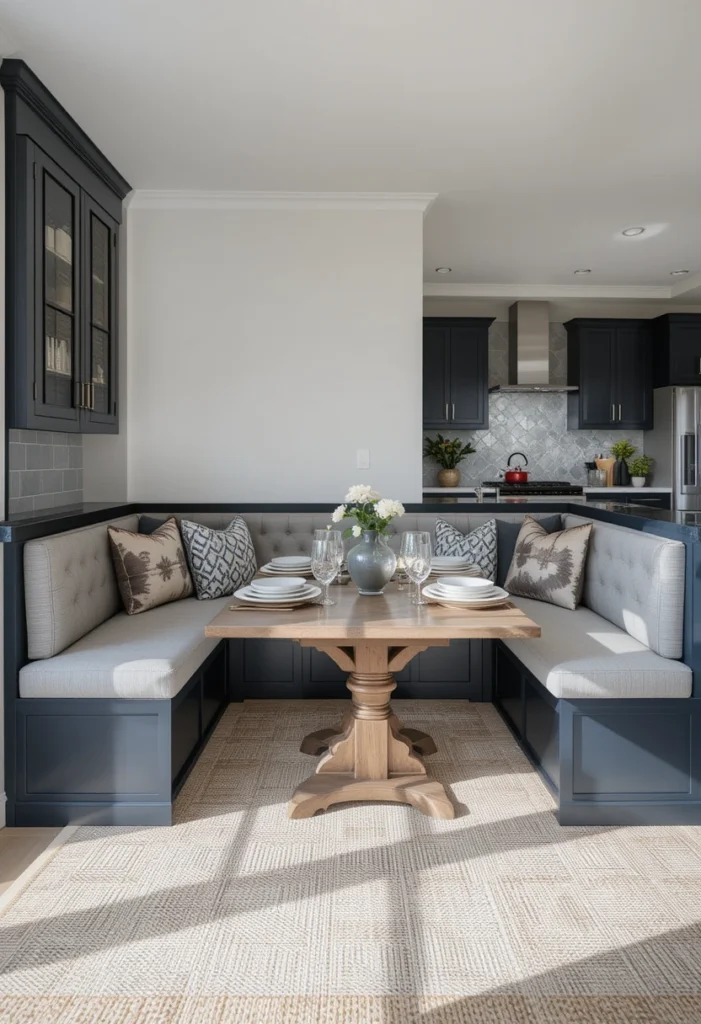
Seating space Built-in seating provides a natural boundary and contributes to the functional space in your kitchen which would be there on one side of your kitchen. I have witnessed this done beautifully with L-shaped banquettes that outline the edge of the kitchen as well as giving comfortable seating to have casual meals.
Bringing It All Together: My Personal Recommendations
Having experimented with a number of techniques in my own house, and observed what works in hundreds of other places, I would suggest commencing with the following:
On a tight budget: Begin with flooring and general lighting modifications. These will have the most effect with the least amount of investment.
In case you desire medium impact: Add a kitchen island or a console table. These divide physically as well as make it functional.
With commitment to do so: Think flooring change or architecture such as half walls.
The fact is, it is not so beautiful kitchen division as about being fixed to the strict rules, it is knowing what your space is and what your lifestyle is. What has been successful at my place may require some adjustment to yours and that is all fine.
Making Your Choice: What Works for Your Space?
The ideal way of dividing your open kitchen to the most beautiful will be depending on your needs, budget and the kind of style you prefer. Do you love to have fun and must find solutions that are flexible? Or do you like solid things to make distinct defined areas?
Imagine your day to day activities, your eating habits and how you practically make use of your space. The biggest beautiful segment in the world will not work because it does not belong to your lifestyle.
It is not essential to remember that you do not need to pick only one of them. A combination of several methods can lead to the most advanced and effective outcomes. My kitchen incorporates an island, multiple lighting areas, and the placement of the furniture, and it fits perfectly well.
It is not about perfection, it is about establishing a space that feels like it was meant to be, beautiful, and ideal in how you live. Take these thoughts and make them fit in your room and build the divided-but-open kitchen of your dreams. Believe me, once you once get it right you will wish that you never lived without these defined zones! 🙂
